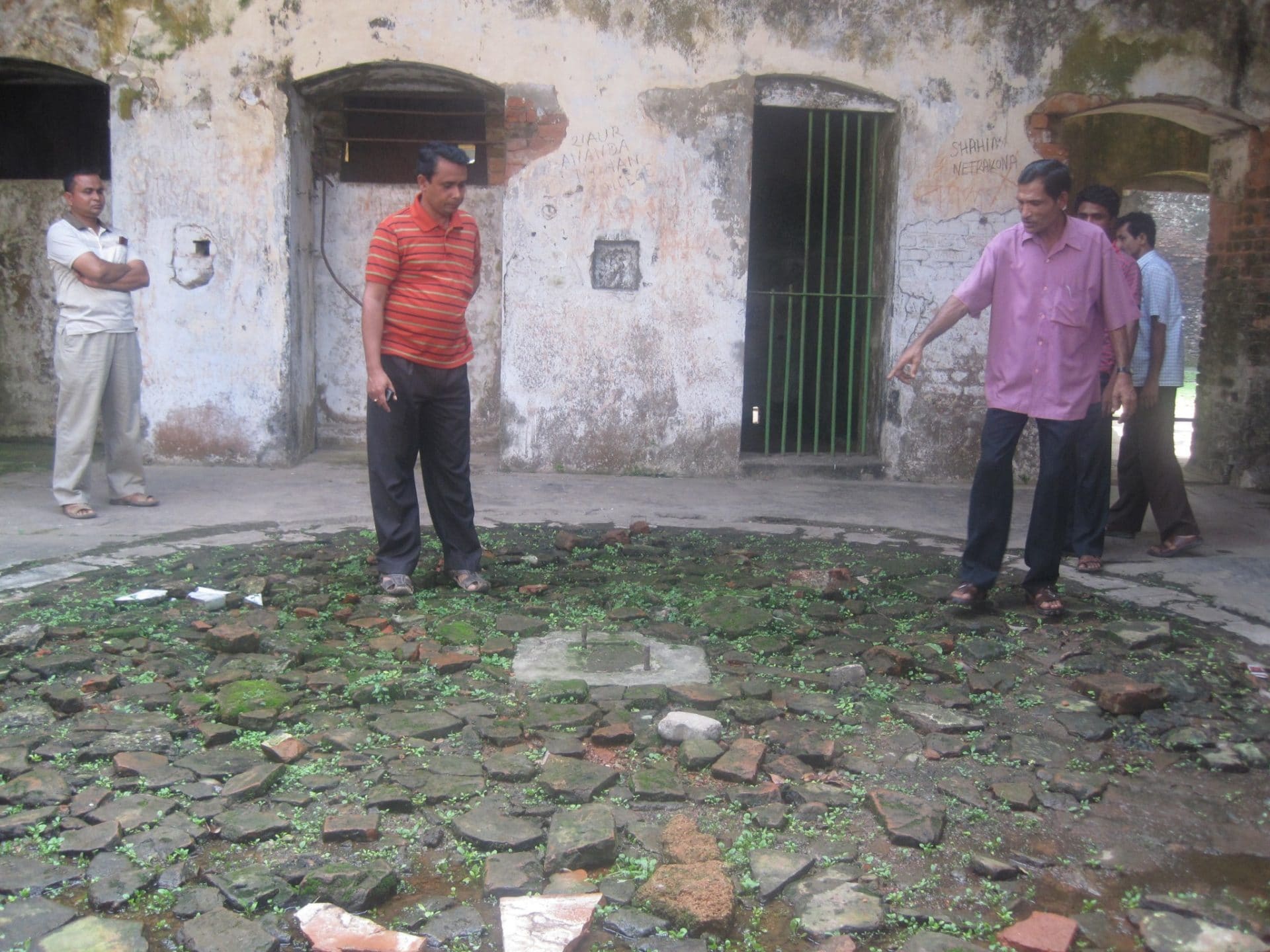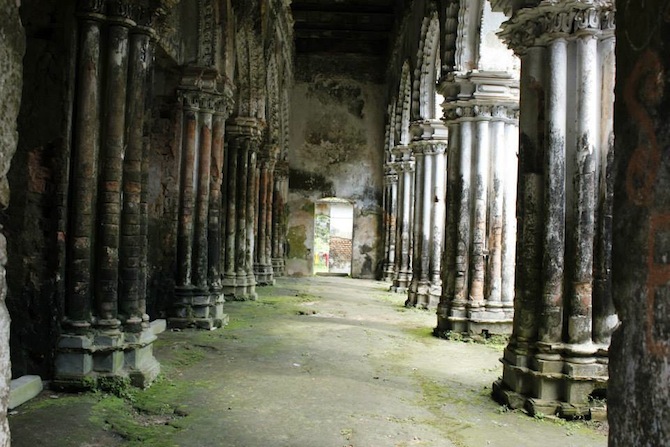Revolving stages, a decrepit old heritage home and the mouth watering sweet Monda, a day trip to the eastern part of Bangladesh, a place called Muktagacha was an enticing prospect. Muktagacha is famous for housing the prestigious Bangladesh Agricultural University as well as historic zamindar bari (landlord house) that dates back roughly 300 years ago. Popularly known as the Muktagacha Rajbari, the zamindars (landlords) that lived here used their influence during the colonial era of the British, after 1757 AD, to grow quite a stronghold. With an estimated 99 elephants, the landlord hired French and British architects to design various features of their palatial house.Yet, tourists often make a day trip to Muktagacha to not only visit these important attractions, but to simply eat one of the most famous desserts in Bangladesh: the Muktagacha Monda. A grainy sort of soft yogurt patty, when you bite into it the individual granules of the cooked yogurt separate and fill the mouth with their sweet goodness.

The revolving stage. Photo courtesy of Reema Islam.
Sweet Success
With their 99 elephants and scores of cows and other livestock, the landlords — who were the family of the Acharya Chaudhurys — were one of the most influential people of the area. When a humble mishti (sweetmeat maker) presented the Maharaja (high king) with a unique creation of his in 1824 AD, he was instantly employed. Thus, Mr. Gopal Pal enjoyed the privileges of being the official sweetmeat maker of the Maharaja, who had more than his fair share of occasions required to serve his guests with delicacies from the dessert cart.
A great admirer of the performing arts, the Maharaja had the French build him a stage that revolved and regaled his guests with performances of famous courtesans and classical musicians of that era. He then had the Japanese build him “air conditioned” accommodation, with shafts and a roomy courtyard to allow air passages. Some traces of an earthquake resistant framework are also visible as are the odd Mughal and heavy British influences. They tell of a family that was cultured and had impeccable taste. Yet, these landlords hailed from more humble origins and had simply derived tax collecting rights at some point after the British gained colonial power post 1757 AD and thus, they became land owners and earned a position in society brought about through flashing around their money rather than noble roots.
Now Mr. Pal’s family thrived in their lovely little world where they specially prepared the Monda sweets for the Maharaja and gained his kindness and benevolence; however, when the partition of the subcontinent took place between neighboring countries India and Pakistan in 1947, the adopted son of the great Maharaja fled, never to return, leaving the Corinthian pillars and his palatial residence in the hands of time and the Bangladeshi Archaeology department. Neither has been kind to the Muktagacha Rajbari, but Mr. Pal benefited heavily. He set up shop with his savings and started selling his award worthy sweet and soon, he was a national treasure.

Muktagacha Rajbari. Photo courtesy of Rizwanul Islam Chandan.
Tasting History
When I visited his shop through a study course, we were in desperate need of comfort food after hearing the local guide accentuate the story of how the Maharaja required all prospective new brides to present themselves unto him, an ode to his carnal avarice. In a tradition much like the “right of the Lord,” the Maharaja is even said to have locked up parents unwilling to follow in with this painful submission of their daughter’s chastity. So we eagerly sought the shop right across the street; it looked old but newer than the dilapidated rajbari we had just visited, proudly stating its start of operation from 1824 AD.
We all managed to jostle in en masse and noticed a huge wooden statue of a man. Mr. Pal himself sat squatting with a plate of food in front of him, possibly to whet appetites of the customers; however, we didn’t need any encouragement and ordered several plates from the various monda varieties.
I pointedly sat with my back to the surreal looking Mr. Pal in his tiled abode with a glass window. His wooden countenance in his loin cloth and extended hand holding a fan was rather unsettling. It actually took them a while to serve us while we sat admiring the wooden beams and the sparsely decorated venue with wooden chairs and benches, as food is always served fresh.
Several kinds of monda are served: the brownish monda made with molasses, white ones made with sugar, in two bite sized rounds that are not wobbly but crumble easily when dug in with the aluminum square-shaped spoons they served us. The mondas are soft and make a squeaky sound when chewed as the yogurt grains get crushed by the molars.
Made when the yogurt is cooked and sugar added, the original recipe is pretty much a well kept secret. That being said, the mishti has numerous variations which transcend across the Bengali culture of not just Bangladesh but also the Bengal province of India. So as we sat with our cheeks full of the Muktagacha famous monda, thinking of the performances that might have happened on the revolving stage, the grandeur of the Corinthian pillars in the days gone by and the fate of the poor brides-to-be, who possibly fed their guests with the very same monda, made by the ancestor of the shop owners today.
The monda stood testimony to the times of the British, the Indian sub-continent’s partition from them of, Bangladesh’s eventual independence as a separate nation and yet, it retained its sweet and simple form, never changing.
Contributed by Reema Islam, who has a degree in Environmental Sciences and an active passion for archaeology.

Jessica Festa is the editor of the travel sites Jessie on a Journey (http://jessieonajourney.com) and Epicure & Culture (http://epicureandculture.com). Along with blogging at We Blog The World, her byline has appeared in publications like Huffington Post, Gadling, Fodor’s, Travel + Escape, Matador, Viator, The Culture-Ist and many others. After getting her BA/MA in Communication from the State University of New York at Albany, she realized she wasn’t really to stop backpacking and made travel her full time job. Some of her most memorable experiences include studying abroad in Sydney, teaching English in Thailand, doing orphanage work in Ghana, hiking her way through South America and traveling solo through Europe. She has a passion for backpacking, adventure, hiking, wine and getting off the beaten path.








